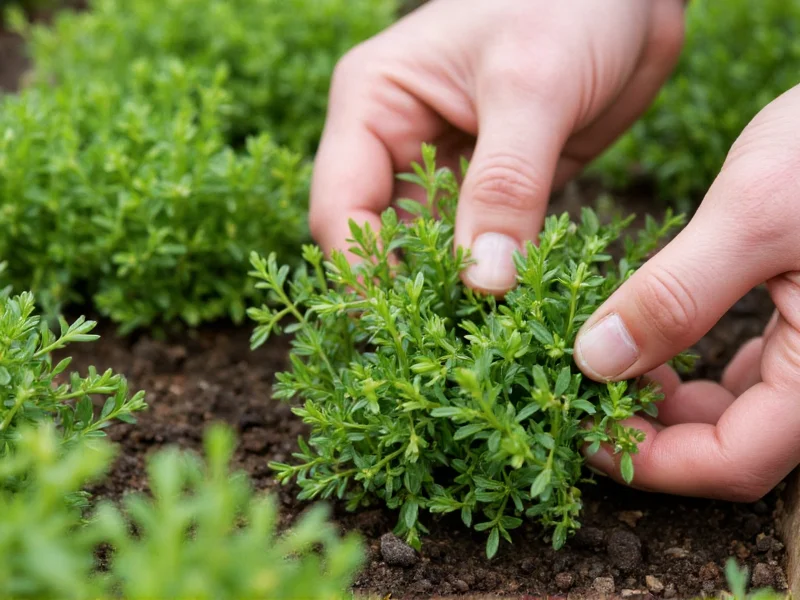Creating the Perfect Environment for Thyme
Thyme (Thymus vulgaris) requires specific growing conditions to flourish. Unlike many herbs, thyme actually prefers poor, sandy soil rather than rich compost. The key to successful planting thyme in garden beds is excellent drainage—this Mediterranean native suffers in waterlogged conditions. Aim for soil with 6.0-8.0 pH, though thyme tolerates a wide range. Raised beds work exceptionally well for growing thyme in heavy soil areas, improving drainage while maintaining warmth.
When considering best time to plant thyme outdoors, spring after your last frost date provides ideal establishment conditions. Fall planting works well in warmer climates (zones 7-9), giving roots time to establish before winter dormancy. For container planting, choose pots with multiple drainage holes and use a cactus/succulent mix for optimal results.
Step-by-Step Thyme Planting Guide
Follow these precise steps for successful thyme establishment:
- Prepare the soil by loosening to 12 inches deep and mixing in sand or perlite if drainage is questionable
- Dig holes matching the depth of nursery containers, spacing 12-24 inches apart (24" for vigorous varieties)
- Gently remove thyme from container, loosening any circling roots
- Place in hole, ensuring crown sits at soil level—not buried
- Backfill with native soil, pressing gently to eliminate air pockets
- Water thoroughly until soil is moist but not saturated
- Apply 1/2 inch gravel mulch to prevent stem rot (avoid organic mulches)
| Planting Factor | Optimal Condition | Problem Indicators |
|---|---|---|
| Sun Exposure | 6-8 hours direct sun | Leggy growth, reduced flowering |
| Soil Drainage | Fast-draining, gritty texture | Yellowing leaves, root rot |
| Watering Frequency | Dry 1-2" soil between waterings | Mold, wilting despite wet soil |
| First-Year Care | Minimal fertilizer, no pruning | Weak stems, excessive leaf drop |
Avoiding Common Thyme Planting Mistakes
Many gardeners make critical errors when starting thyme from seedlings. Overwatering causes 80% of thyme failures in the first season—this drought-tolerant herb prefers underwatering to overwatering. Another frequent mistake involves improper spacing; crowded thyme plants develop poor air circulation leading to fungal diseases. When planting thyme near other herbs, keep it separate from moisture-loving varieties like mint or basil.
For those attempting how to plant thyme seeds directly outdoors, understand that germination takes 14-28 days with consistent moisture. Seeds require light to germinate, so press them gently onto the soil surface rather than covering deeply. Many beginners achieve better results with transplants during their first season.
Troubleshooting Early Growth Problems
Yellowing lower leaves typically indicate overwatering or poor drainage—immediately reduce watering frequency. If your newly planted thyme isn't growing, check for root-bound conditions from the nursery container. Gently tease apart circling roots before planting to encourage outward growth. In cool, wet springs, watch for damping-off disease; remove affected plants immediately and improve air circulation.
For gardeners in humid climates wondering why thyme keeps dying after planting, consider growing upright varieties like 'German Winter' instead of creeping types. Container growing with excellent drainage often solves persistent moisture issues. Remember that thyme establishes slowly the first year but becomes vigorous in year two.
Seasonal Care for Newly Planted Thyme
During the establishment phase (first 6-8 weeks), water deeply once weekly unless receiving regular rainfall. After establishment, mature thyme needs watering only during extended droughts. In fall, avoid heavy pruning before first frost—this stimulates tender growth vulnerable to cold damage. Instead, perform major pruning in early spring as new growth appears.
For those practicing companion planting with thyme, it grows well alongside cabbage, eggplant, and strawberries while deterring pests. Avoid planting near moisture-loving herbs. Thyme's shallow root system means it competes poorly with aggressive growers like mint, so maintain adequate spacing.
Frequently Asked Questions
Can I plant thyme in the summer?
Yes, but with precautions. Summer planting requires afternoon shade protection and more frequent watering during establishment. Morning planting reduces transplant shock. Avoid planting during heat waves above 90°F (32°C) as thyme enters dormancy in extreme heat.
How deep should thyme roots be planted?
Plant thyme at the same depth it grew in its nursery container. The crown (where stems meet roots) should sit level with the soil surface. Burying the crown causes stem rot, while planting too shallow exposes roots. For seed starting, cover seeds lightly—no more than 1/8 inch deep.
What soil amendments help thyme growth?
Thyme prefers lean soil with minimal amendments. If your soil retains too much moisture, mix in coarse sand or perlite (up to 30% of total volume). Avoid compost and nitrogen-rich fertilizers which promote excessive leafy growth at the expense of essential oil production. A handful of crushed eggshells per plant provides adequate calcium without enriching the soil excessively.
How long until newly planted thyme is ready for harvesting?
Wait until your thyme plant has doubled in size before harvesting—typically 60-90 days after planting. Never remove more than one-third of the plant at once. The best time for harvesting is just before flowering when essential oil concentration peaks. Morning harvests after dew evaporates yield the most flavorful leaves.
Does thyme need fertilizer after planting?
No, thyme generally doesn't require fertilizer. Excessive nutrients, especially nitrogen, reduce essential oil concentration and make plants more susceptible to disease. If growth appears weak after one year, apply a balanced organic fertilizer at 1/4 strength in early spring. Most established thyme plants thrive with no additional feeding.











 浙公网安备
33010002000092号
浙公网安备
33010002000092号 浙B2-20120091-4
浙B2-20120091-4